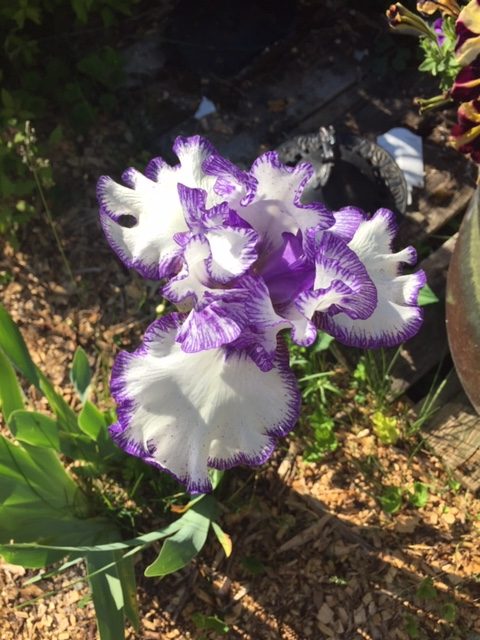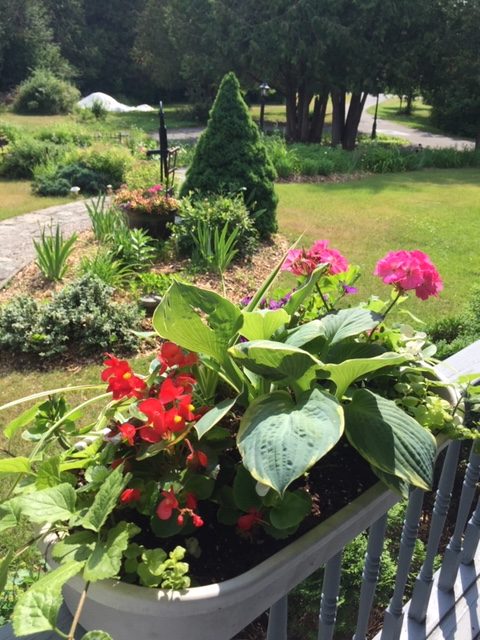Gadbois: What’s growing in my garden?
The growing season is finally here! I am so pleased to be able to walk outside with coffee in hand in the morning and to inspect the garden to see what has popped up overnight. The grass is doing well and needs a regular biweekly mow now.

Dandelions are gone and did not seem to linger much this year because of the early swelter of heat we experienced. Weeds are back, but if attended to daily, manageable. Life has exploded on the property, it’s hard to keep up with the beauty of late spring-early summer when my mostly perennial garden shines in its bounty.
Over the years, I have become partial to the iris, a mid-to-late spring blooming perennial which comes to inflorescence a little earlier than and alongside the peonies. Bearded irises (Iris germanica) have fat fleshy roots called rhizomes, which grow very close to the soil surface and with one central showy flower stalk. Siberian irises are those with a mass of thinner stalks and smaller blooms. Siberian irises (Iris siberica) are easy to grow with lovely foliage and a tall slender habit.
Irises provide beautiful spring colour and shape…mainly blues, mauves and whites, and there are also the later season varieties, hybrids with mixed colours of white and blue or purple, chocolates, all quite regal and striking. The nice thing about irises is that they are relatively pest free, apart from the iris borer in the bearded variety which can harm the root, a rhizome, and kill the plant. In my experience, this is not very prevalent. They are easy to propagate by division, usually in the fall once the leaves have faded to yellow.
The variety to really be careful about planting is the Yellow Flag Iris (Iris pseudacorus) which is invasive and takes over wetlands, crowding out other native species.

Just last week, the peonies emerged out of their tight ant infested bud balls, all resplendent in colour and lushness. Peonies (Paeonia, spp) can be herbaceous perennials, though some are woody shrubs. Mine are herbaceous and die down to the ground every year, grow about waist high with bounteous blooms and persistent foliage throughout the growing season. Where there is a peony plant, no need to worry about planting succession greenery because they retain their form throughout the summer and fall. Too bad they only bloom for a short time, from six to ten days, because they are the perfect perennial border plant. They prefer moderate temperatures to conserve their lovely blooms, extreme heat makes them blow out quickly. Peonies are not difficult to propagate, as long as we remember to plant them with roots very close to the soil surface, in a sunny location and well drained soil. They don’t like to be moved much though, patience is of the essence – it might take a few years for them to recover and flower against they are moved.
While most of my garden blooms are from herbaceous perennials and woody flowering shrubs, I do rely on containers to provide reliable colour throughout the season. This year, unlike no other because of the continuing challenges of the pandemic, obtaining flowering annual plant stock for containers has been a little more difficult.
Many compromises have been necessary but sometimes with surprisingly happy results. Finding that there was lack of variety of plants for containers on the market earlier this season because of cultivation and distribution challenges faced by commercial growers, I turned to some creative ways to reuse and propagate plant material from a variety of sources.
Some plants are carry-overs from last year (e.g., geraniums overwintered in the house), some are indoor house plants (e.g., spider plant offshoots I clipped from the mother plant), some are gifts from a neighbour’s garden like the Yellow Archangel (Lamiastrum galeobdolon) which trails beautifully, and some are perennials which I have divided and will return to the garden in the fall (the hardy hosta used as a shady container centrepiece). The result so far is quite stunning and my annual plant budget has also been impacted positively.

Never a dull moment in the garden, always some issue to address! The extreme heat of the past few weeks has slowed down my gardening stamina and enthusiasm and increased my watering duties (containers and tender perennials only), but the heat wave is abating somewhat and I expect to be back out there again soon.
Meanwhile, garden centres have reopened and with proper social distancing, we can venture forth into them and into the newly reopened farmers’ markets for produce and plants. Local farmers and growers in West Carleton can be contacted online and at the market now, and we can often order and pick up their produce at their home locations.
The garden clubs have chosen to sequester until the fall, many having cancelled their summer garden tours and plant sales which usually attracted a lot of attention from members and the public alike at this time of year. I, for one, am really missing the tours which provide opportunities to see what grows best in local gardens.
Because I handle the newsletter, Facebook and Instagram pages for the West Carleton Garden Club, I have sent a request out to our members to share some pictures of their gardens on our social media pages over the coming weeks. Do take a look at our pages, and at those of other garden clubs and the Master Gardeners of Ottawa-Carleton. If you would like more information on the club or to submit a photo, you can reach me here: newsletter@wcgc.ca.
Happy gardening…the one activity which seems to take my mind off the current context, quite the salutary occupation.
Anne Gadbois is a long-time member of the West Carleton Garden Club and its past president. Gadbois, who lives in Corkery Woods. Anne writes on the wonders and challenges of gardening in our large, geographically diverse area.



